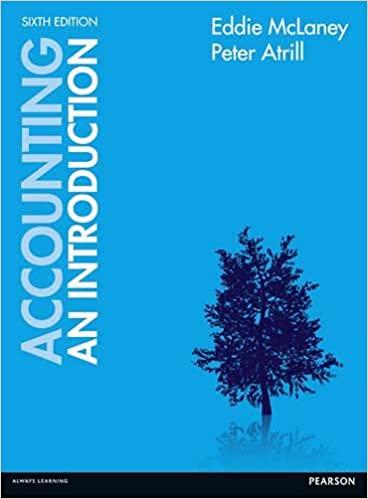Answered step by step
Verified Expert Solution
Question
1 Approved Answer
Need help with this problem ty Olgivie Company had a bad year in 2016. For the first time in its history, it operated at a
Need help with this problem ty 

Olgivie Company had a bad year in 2016. For the first time in its history, it operated at a loss. The company's income statement showed the following results from selling 60,000 units of product: sales $1,800,000; total costs and expenses $2,010,000; and net loss $210,000. Costs and expenses consisted of the amounts shown below. Total Variable Fixed Cost of Goods Sold 1,350,000 930,000 420,000 Selling Expenses 480,000 125,000 355,000 Administrative Expenses 180,000 115,000 65,000 Column Totals 2,010,000 1,170,000 840,000 Management is considering the following independent alternatives for 2017 b1. Increase unit selling price 25% with no change in costs, expenses, and sales volume. b2. Change the compensation of salespersons from fixed annual salaries totaling $200,000 to total salaries of $20,000 plus a 5% commission on net sales. b3. Purchase new high-tech factory machinery that will change the proportion between variable and fixed cost of goods sold to 50:50. (a) Compute the break-even point in dollars for 2016. (b) Compute the break-even point in dollars under each of the alternative courses of action. (Round all ratios to nearest full percent.) (a) FYI: Sales were $1.800,000: Variable cap were 51.172.000 CW - Sules-Var Exp) ... CM Ratio - Sales - Ver Expo / Sales (6-1) FYI: Calculate new selling price by ($30 x 125%). New selling price causes "Total Sales to increase which changes the CM and the CM ratio. (6-2) FYI: "Total fixed costs" drop by ($200,000 - $20,000). "Total variable costs increase by (5% of sales). Sales remain at $1,800,000. The increase in variable costs means a new CM. New CM means new CM ratio. Use the new CM ratio to calculate BE in dollars. (6-3) FYI: The effects of this alternative are:Sales remain unchanged af $1,800,000 (1) variable and fixed CGS become $675,000 each, (2) total variable costs become $915,000 (5675,000+ $125,000 + $115,000), and (3) total fixed costs are $1,095,000 ($675,000 - $355,000 + $65,000). Equation is: X = ($915,000 = $1,800,000)X + $1,095,000 (I apologize for "x"ing you) (First solve inside the parentheses) ... round that answer to 2 decimal places (as in .??X. (Notice decimal point before "X"). Then X = (".??X + $1,095,0000). (Ex: If your calc (above) gave you an answer like (.73X + 1,095,000) (pay attention to decimal point before 73) ... then you would add .27 to each side of the equation giving you.27X on the left side ... (why.27 cuz 1.00 - .73 = 27). Then divide both sides by .27 to get a single whole X (and yes "X" (your final answer) will be larger than the $1,095,000) 

Step by Step Solution
There are 3 Steps involved in it
Step: 1

Get Instant Access to Expert-Tailored Solutions
See step-by-step solutions with expert insights and AI powered tools for academic success
Step: 2

Step: 3

Ace Your Homework with AI
Get the answers you need in no time with our AI-driven, step-by-step assistance
Get Started


